- June 26, 2025
- By Rebecca Washington
- Uncategorized
Is It Bad to Not Clean Gutters? The Hidden Cost of Neglect in Melbourne
Is It Bad to Not Clean Gutters? The Hidden Cost of Neglect in Melbourne
When it comes to home maintenance in Melbourne, Australia, some tasks often get pushed to the bottom of the to-do list. One of the most overlooked, yet critical, is gutter cleaning. Homeowners frequently ask, “Is it bad to not clean gutters?” The short answer? Absolutely. With Gutter Cleaning Melbourne, let’s explore why in much deeper detail—especially considering Melbourne’s unique climate, architecture, and foliage.
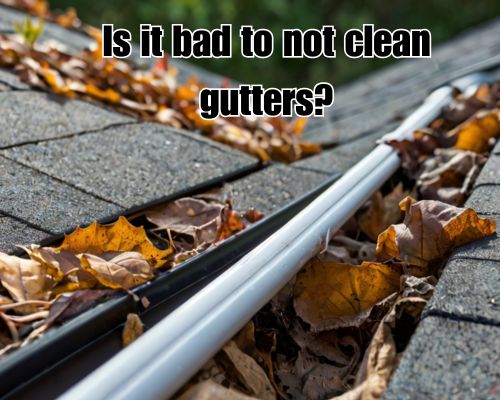
The Silent Threat: Why Gutters Matter More Than You Think
Gutters are the unsung heroes of any building. Their primary function is to redirect rainwater away from your roof, walls, and foundation. In a city like Melbourne, where seasonal rains, gusty winds, and gum tree debris are part of the natural rhythm, gutters play an even more vital role.
Failing to clean them regularly can set off a chain of events that leads to costly structural damage, health hazards, and even diminished property value.
What Happens When Gutters Are Not Cleaned?
Here’s a breakdown of the potential consequences when you ignore your gutter system:
1. Roof and Fascia Damage
Clogged gutters mean water backs up onto your roof. Over time, this leads to:
- Rotting fascia boards
- Water seeping into the ceiling cavity
- Mould and mildew growth
Melbourne homes, particularly in older suburbs like Carlton, Fitzroy, or Northcote, often feature weatherboard exteriors and pitched roofs, which are especially vulnerable to water intrusion.
2. Foundation Cracks and Erosion
Uncontrolled overflow can saturate the soil around your home, compromising the foundation integrity. Water pooling around the base of your home may cause:
- Soil erosion
- Concrete cracking
- Subsidence, which is particularly problematic in clay-heavy Melbourne suburbs like Bentleigh and Clayton
3. Basement Flooding
For homes with basements—a feature becoming more popular in Melbourne’s newer developments—clogged gutters increase the risk of flooding. Once water seeps in, it can:
- Damage stored items
- Create a breeding ground for black mould
- Invite unwanted pests
The Melbourne Factor: Why Local Conditions Make It Worse
🟡 Native Tree Debris
Melbourne’s abundant eucalyptus and gum trees shed leaves and bark that clog gutters easily. In leafy suburbs like Camberwell and Eltham, it’s common for gutters to become blocked within just a few months.
🟡 Four Seasons in One Day
Melbourne’s famously unpredictable weather leads to repeated cycles of dry debris becoming wet and heavy during sudden rainfalls, which accelerates gutter corrosion and sagging.
🟡 Bushfire Risk
During warmer months, dry leaves and debris in gutters increase the risk of fire hazards, especially in fringe suburbs such as Warrandyte and the Dandenong Ranges.
Pest Infestations: A Dirty Gutter’s Best Friends
Stagnant water in blocked gutters creates the perfect environment for:
- Mosquito breeding
- Cockroach colonies
- Rodents and possums nesting
And with Melbourne’s suburban wildlife—particularly in areas bordering natural reserves like Bundoora Park—this is not a hypothetical scenario. Pest control issues stemming from clogged gutters can easily spiral into thousands of dollars in remediation costs.
Structural and Aesthetic Consequences
A neglected gutter system can lead to:
- Paint damage and streak marks on walls
- Siding deterioration
- Uneven paving from redirected water runoff
These issues not only harm the structure but devalue your home, especially important in Melbourne’s competitive property market. Whether you’re in Brunswick or Brighton, kerb appeal plays a significant role in valuation.
Insurance May Not Cover Gutter-Related Damage
Here’s a major kicker: many home insurance policies in Victoria exclude water damage that results from lack of maintenance. That means if your ceiling caves in due to a blocked downpipe or your garden floods due to an overflowing gutter, you’ll foot the bill.
Gutter neglect is classed as a preventable issue—and if you don’t take proactive steps, it could cost you far more than a regular cleaning would.
How Often Should You Clean Gutters in Melbourne?
Experts and local councils (like the City of Melbourne) recommend cleaning your gutters:
- At least twice a year, typically in autumn and spring
- Quarterly, if your property is surrounded by large trees
- More frequently during storm season or bushfire season (Nov–Mar)
Some homeowners opt for professional gutter services like Gutter Cleaning Melbourne that offer annual maintenance contracts. These are cost-effective and can even include inspections to spot rusting, leaks, or poor pitch.
Cost vs Consequences: Is Gutter Cleaning Worth It?
Yes. When compared to the costs of roof repairs, pest control, or foundation work, gutter cleaning is relatively inexpensive in Melbourne. On average, services range from $150–$300 depending on:
- House size
- Accessibility
- Number of stories
- Level of debris
Compare that with:
- Roof repair: $2,000–$10,000
- Foundation repair: $5,000+
- Interior water damage: $1,500+
It’s clear that neglect is more expensive than prevention.
DIY or Hire a Pro?
If you’re confident on a ladder and know how to handle a garden hose, DIY gutter cleaning might suffice—particularly for single-story homes in suburbs like Thomastown or Preston. However, for homes with multiple stories, steep roofs, or fragile tiles (common in heritage-listed Melbourne houses), professional cleaning is safer and more effective.
Look for professionals that:
- Offer before-and-after photos
- Provide roof and gutter inspections
- Are insured and accredited
Some trusted Melbourne providers even use vacuum gutter systems and drone inspections, providing a thorough, mess-free result.
Final Thoughts: Don’t Let Gutters Be Your Home’s Achilles’ Heel
So, is it bad to not clean gutters? In Melbourne’s environment, it’s not just bad—it’s a serious risk. From foundation damage and pest infestations to higher insurance premiums and property devaluation, the impacts of neglected gutters are extensive.
Think of gutter cleaning as a form of home insurance you control directly. For a small annual investment, you protect your roof, your walls, your foundation—and your sanity.
🟢 Whether you’re a homeowner in Essendon or an investor in Southbank, regular gutter maintenance is a non-negotiable part of responsible property care in Melbourne.
Suggested Local Services and Resources
- Melbourne Gutter Cleaning Professionals – offering quarterly maintenance plans
- City of Melbourne Home Maintenance Advisory – guidelines and safety tips
- Victoria SES FloodSafe – resources on flood prevention through gutter maintenance
💡 Takeaway Tip: Schedule your next gutter clean before Melbourne’s unpredictable spring storms hit, and consider installing gutter guards for long-term peace of mind.
…
- June 23, 2025
- By Rebecca Washington
- Uncategorized
Why Is Roof Work So Expensive? A Deep Dive into Roofing Costs in New Jersey
Why Is Roof Work So Expensive? A Deep Dive into Roofing Costs in New Jersey
If you’ve recently received a roofing estimate in New Jersey and nearly fell off your ladder after seeing the price, you’re not alone. Homeowners across the Garden State are asking the same question: Why is roof work so expensive? From labor rates and material prices to local regulations and weather conditions, several key factors drive up the cost of roofing in NJ.

With CJ Commercial Roofing NJ, let’s break down these elements to help you understand why your roofing quote might be higher than expected—and what you can do to make smart decisions when replacing or repairing your roof.
1. The Price of Materials: Rising Costs and Quality Considerations
One of the biggest drivers of high roofing costs is the price of materials. Whether you’re opting for traditional asphalt shingles, sleek metal roofing, or environmentally friendly synthetic options, the cost per square foot has soared in recent years.
In New Jersey, the average price of asphalt shingles can range from $90 to $150 per square (a roofing “square” is 100 sq ft), and premium materials like architectural shingles or standing seam metal roofs are significantly higher.
Why the hike?
- Inflation: Like everything else, roofing material prices have been impacted by inflation.
- Supply chain disruptions: The pandemic-era bottlenecks are still echoing through the supply lines.
- Energy-efficient upgrades: Many NJ homeowners opt for better-insulated materials, which are pricier upfront.
If your roofer in Newark, Edison, or Princeton quoted you a hefty price, rest assured—material costs are a legitimate contributor.
2. Labor Costs: Skilled Work in High Demand
Skilled labor is another major reason roof work is so expensive in New Jersey. Unlike painting or landscaping, roofing is hazardous, technical, and physically demanding. It requires trained professionals with knowledge of NJ building codes, safety protocols, and installation techniques tailored to the region’s unique climate.
What affects labor rates?
- Licensing and insurance requirements in New Jersey push up contractor overhead.
- Demand exceeds supply: Roofing contractors in NJ are in high demand, especially after harsh winters or storm seasons.
- Safety precautions: Workers need proper harnessing, insurance, and gear—especially in steep-slope or multi-level homes common in places like Montclair or Jersey City.
Expect labor alone to make up 60% or more of your total roof replacement cost.
3. Permits and Regulations Unique to NJ
New Jersey is known for stringent building codes, especially in municipalities like Hoboken, Summit, or Asbury Park. Before any roofing begins, contractors must pull permits that ensure the job meets local zoning regulations, fire codes, and energy efficiency standards.
Permit fees can range from $150 to over $500 depending on your city and the scale of the project. Inspections are mandatory, and failing one can mean expensive delays.
Homeowners in coastal areas of New Jersey, like Atlantic City or Ocean County, must also consider wind uplift regulations due to the region’s exposure to Nor’easters and hurricanes.
4. The Hidden Complexity of Roofing
At a glance, a roof may look like just a flat surface with shingles—but the reality is far more complicated.
Roofing contractors must consider:
- Slope and pitch (steep roofs cost more)
- Tear-off vs. overlay (removing old roofing is labor-intensive)
- Multiple layers of roofing (common in older NJ homes)
- Chimneys, skylights, and vents, which require intricate flashing
This complexity leads to more labor hours, more materials, and higher costs. A roof in the historic districts of Morristown or Westfield might have architectural quirks that require specialized craftsmanship—adding thousands to the estimate.
5. New Jersey Weather Isn’t Helping
Another reason roof work is so expensive in NJ? Weather. The Garden State experiences all four seasons—harsh winters, wet springs, humid summers, and fall storms. That means your roof must be built to withstand snow loads, ice dams, UV rays, and torrential rain.
Roofers also face seasonal constraints. Winter slows down most installations, so when spring and summer roll around, demand spikes—driving prices higher. It’s common to see seasonal price surges in places like Trenton or Bergen County.
6. Roofing Insurance and Liability
Roofing is considered high-risk construction, so insurance premiums for roofing companies are extremely high. In New Jersey, contractors are required to carry both general liability and workers’ compensation insurance. These protections are crucial for homeowners, but they also contribute to higher job costs.
If your roofer lacks proper insurance—run. A cheaper quote without coverage could leave you legally liable for worker injuries.
7. Roofing Warranties and Long-Term Value
Another factor to consider is the value of warranties and guarantees. Reputable New Jersey roofing contractors often provide manufacturer warranties (25-50 years) and labor warranties (5-10 years). These protections come at a price but offer peace of mind and long-term ROI.
While upfront costs seem high, quality work with a strong warranty can save you thousands in future repairs.
8. The Cost of Living in New Jersey
Let’s not forget that New Jersey is consistently ranked among the top 10 most expensive states to live in. From property taxes to labor rates, everything costs more in NJ—including roofing.
Areas like Bergen, Morris, and Somerset counties tend to have higher labor and permit fees compared to more rural regions. If you’re in northern NJ or the greater NYC metro area, roofing quotes will reflect that premium.
9. Tips for Managing High Roofing Costs in NJ
Here are some smart strategies for homeowners to mitigate high roofing prices:
- Get 3–5 estimates from licensed NJ roofers for comparison. See CJ Commercial Roofing NJ.
- Time it right: Schedule in late fall or winter for potential off-season discounts.
- Ask about financing: Many NJ contractors offer roof financing or payment plans.
- Check your insurance: Wind, hail, or storm damage may be partially covered by your homeowner’s policy.
- Consider energy rebates: NJ offers energy efficiency programs that might apply to your roof upgrade.
Final Thoughts: The Price Reflects the Protection
So—why is roof work so expensive in New Jersey? Because it’s a high-stakes, high-skill job in a high-cost region. From material prices and contractor wages to local building codes and insurance requirements, every line item reflects a crucial piece of the puzzle.
In a climate like New Jersey’s—where snow, storms, and sun can all show up in the same week—your roof is your home’s first and best defense. Investing in a solid roofing system means protection, peace of mind, and long-term value.
Still, don’t just settle for the first quote. Take your time, do your homework, and work with licensed NJ roofing professionals to ensure you’re getting quality work for the right price.
🔍 Interested in comparing local roofing quotes in New Jersey? Search for “licensed roofers near me in NJ” or visit your county’s home improvement registry for verified professionals. Roof smart—because your home deserves the best.
…
- June 23, 2025
- By Rebecca Washington
- Uncategorized
How Much Does a Roofing Business Cost?
How Much Does a Roofing Business Cost?
Starting a roofing business can be a rewarding venture—especially in states like New Jersey, where weather variability and aging infrastructure create consistent demand for quality roofing services. But before you strap on your toolbelt and print business cards, a practical question looms: How much does a roofing business cost in New Jersey?

This article explores the startup expenses for a roofing business in the Garden State, offering a breakdown of necessary investments, industry insights, and local factors that affect cost. If you’re aiming for sustainability, profitability, and long-term growth, understanding the financial requirements upfront is essential.
📊 Average Startup Costs for a Roofing Business in New Jersey
The total startup cost for a roofing business in New Jersey typically ranges between $15,000 and $40,000. However, this can vary significantly based on the scope of your services, equipment needs, licensing requirements, and location-specific overhead.
Let’s break down the core expenses involved:
🛠️ 1. Equipment and Tools – $5,000 to $15,000
Your primary investment will be in commercial-grade roofing tools and safety equipment. This includes:
- Ladders and scaffolding
- Nail guns, compressors, and hand tools
- Roofing materials (for samples or initial inventory)
- Safety harnesses and PPE
- Generators and storage trailers
In New Jersey, especially in urban areas like Newark, Jersey City, or Trenton, equipment security and mobility also factor into tool selection. Many roofers invest in a locked trailer or mobile workshop to transport and store tools safely.
🚚 2. Vehicle – $3,000 to $10,000 (Used) / $25,000+ (New)
You’ll need at least one work truck or van, preferably with ladder racks and weatherproof storage. If you’re servicing areas across Essex County, Monmouth County, or Bergen County, fuel efficiency and durability are key. Leasing is an option for those looking to manage cash flow.
📋 3. Licensing, Registration, and Insurance – $2,000 to $5,000
New Jersey requires roofing contractors to be registered under the Division of Consumer Affairs. The Home Improvement Contractor (HIC) registration is mandatory, with a $110 application fee.
Other local and legal requirements include:
- Business Registration Certificate
- Liability insurance ($1M+ recommended)
- Worker’s compensation (if you hire employees)
- Vehicle insurance and commercial auto coverage
- Surety bonds (if doing large-scale or government contracts)
In places like Camden, Cherry Hill, and Atlantic City, municipalities may require additional permits or trade licenses, especially for structural or commercial roofing projects.
🧾 4. Office or Workspace – $0 to $5,000
Many New Jersey roofing startups begin as home-based businesses to save on overhead. However, as your operations expand, leasing a small warehouse or office space near a central area like Edison or Woodbridge can be beneficial for logistics and client meetings.
You’ll also need a computer, printer, accounting software, and project management tools like JobNimbus, AccuLynx, or Roofr.
💻 5. Marketing & Branding – $1,500 to $7,000+
In a competitive market like New Jersey, visibility is everything. Roofing is a highly localized service—meaning customers in Toms River will likely choose a different contractor than someone in Hackensack.
Initial marketing expenses may include:
- Logo & brand design
- Website development (SEO-optimized)
- Google Business Profile setup
- Local SEO targeting service areas
- Pay-per-click ads (Google Ads)
- Flyers, door hangers, or yard signs
- Branded uniforms & vehicle wraps
Tip: Focus on geo-targeted keywords like “roof repair Bergen County”, “new roof installation Trenton”, or “emergency leak repair in Hoboken”. These LSI keywords help improve your search engine visibility and drive more qualified leads.
👷 6. Labor Costs (Optional) – Variable
If you’re starting solo, you can delay hiring until demand increases. But if you’re launching with a crew, factor in:
- Wages (average roofer salary in NJ: $20–$30/hour)
- Onboarding and training
- Payroll taxes
- Worker’s comp and benefits
Labor is typically the largest ongoing cost, especially during peak seasons (spring/summer) in areas like Freehold, Paramus, and Bayonne.
📈 Ongoing Expenses to Budget For
In addition to startup costs, consider monthly and annual expenses that affect profitability:
- Materials and supplier payments
- Fuel and vehicle maintenance
- Software subscriptions (e.g., estimating tools)
- CRM or scheduling systems
- Ad campaigns or SEO retainers
- Insurance premiums
Setting aside a 3–6 month working capital reserve is smart financial planning—especially in New Jersey, where seasonal demand fluctuates, and winter months may see a dip in residential roofing projects.
🧠 Local Market Insights: Roofing in New Jersey
🔥 High-Demand Services
New Jersey residents commonly request:
- Asphalt shingle replacement
- Flat roof installation (popular in urban settings)
- Gutter installation and maintenance
- Storm damage restoration
- Roof inspections and certifications
Target older residential neighborhoods in Union City, Clifton, and Paterson, where homes built pre-1980 often need full replacements. See roofing contractors for more.
🧱 Building Code Compliance
Each township may have different permitting, inspection, and code enforcement standards. Staying compliant with NJ Department of Community Affairs and local zoning regulations can prevent delays and fines.
💡 Tips for Lowering Startup Costs
- Buy refurbished tools or lease major equipment
- Partner with local roofing supply distributors for better material rates
- Use digital marketing instead of expensive print media
- Outsource bookkeeping or marketing on a part-time basis
- Apply for small business grants in NJ (EDA, SBA, or Urban Enterprise Zones)
🔚 Final Thoughts: Is the Cost Worth It?
While startup costs for a roofing business in New Jersey can be steep, the return on investment is high when managed properly. With the average residential roofing job ranging from $6,000 to $15,000, even a few contracts a month can generate sustainable cash flow.
And with New Jersey’s population density, diverse housing stock, and frequent weather-related damage, the demand for reliable roofers remains steady year-round.
So, if you’re strategic with spending, compliant with licensing, and aggressive with local SEO, the cost to start a roofing business in New Jersey is more than justified—it’s a solid foundation for a thriving enterprise.
…
- June 23, 2025
- By Rebecca Washington
- Uncategorized
Is Roofing a Stressful Job? A Closer Look at Roofing in West Palm Beach, Florida
Is Roofing a Stressful Job? A Closer Look at Roofing in West Palm Beach, Florida
Roofing is a critical trade in the construction industry, but it often flies under the radar until leaks start dripping or hurricane season looms. For homeowners in West Palm Beach, Florida, where tropical storms and heavy rains are seasonal guests, the demand for reliable roofing services is perpetual. But for those wearing the tool belt, the job isn’t just about shingles and scaffolding—it often comes with a weight heavier than a bundle of asphalt tiles. So, is roofing a stressful job? With Star Roofing, let’s dive deep into the realities of this profession, especially in the context of South Florida’s unique climate, economic landscape, and workforce expectations.
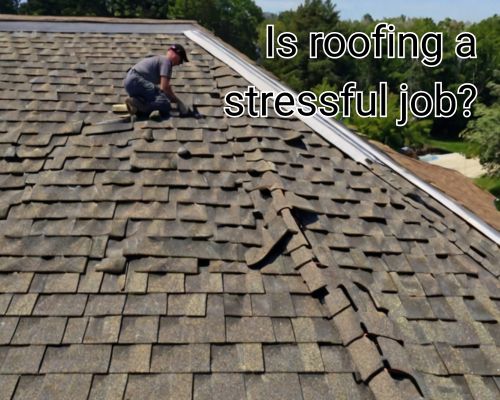
🏗️ The Physical and Mental Toll of Roofing
1. Physical Labor Under Extreme Conditions
Roofing is labor-intensive. Professionals often work long hours in direct sunlight, especially in West Palm Beach, where summer temperatures easily exceed 90°F and humidity hangs heavy in the air. The combination of high heat and hard labor increases the risk of heat exhaustion, dehydration, and fatigue.
Roofers frequently climb ladders, carry heavy materials, balance on steep slopes, and perform repetitive movements—all of which can take a toll on the body over time. According to the U.S. Bureau of Labor Statistics, roofing consistently ranks among the most physically demanding jobs in the construction sector.
2. Mental Stress and Safety Risks
Beyond the physical grind, there’s considerable mental strain involved. Roofers must maintain sharp focus to avoid slips, falls, and other injuries. The pressure is amplified in West Palm Beach, where sudden weather changes can force crews to rush or halt work altogether. Balancing speed, quality, and safety on tight deadlines can heighten anxiety levels, especially for foremen and contractors managing multiple projects simultaneously.
3. Unpredictable Weather and Its Impact
Florida’s subtropical climate presents unique challenges. Afternoon thunderstorms, intense UV exposure, and hurricane threats can disrupt schedules and damage in-progress work. The stress of racing against the weather to finish a job—or repairing a nearly complete project after storm damage—adds layers of unpredictability.
💼 Financial Pressures and Client Expectations
4. Fluctuating Pay and Job Insecurity
While roofing can be a lucrative career, especially for experienced contractors or business owners, income can fluctuate based on seasonality, demand, and market competition. In cities like West Palm Beach, where roofing services are in high demand after storms, competition spikes, and prices often fluctuate.
For employed roofers, the average wage in Florida hovers around $22-$28 per hour, but pay can be inconsistent depending on the company, experience level, and number of ongoing contracts. The uncertainty of consistent work contributes to financial stress, particularly for independent contractors. For more, visit Star Roofing.
5. Dealing with Clients and Expectations
Client interactions can be another major stressor. Miscommunication, changing project scopes, budget disagreements, and post-installation disputes can cause tension. West Palm Beach residents, many of whom own high-value properties, often have high expectations and demand premium craftsmanship. Managing these relationships while maintaining margins and project timelines requires emotional intelligence, patience, and professionalism.
🛠️ Licensing, Insurance, and Liability Headaches
6. Regulatory Compliance in Florida
Florida has some of the most rigorous licensing requirements in the country for roofing contractors. Anyone offering roofing services in West Palm Beach must be licensed through the Florida Department of Business & Professional Regulation (DBPR) and carry the appropriate general liability and workers’ comp insurance.
Keeping up with licensing renewals, safety codes, and building regulations adds an administrative layer of stress, especially for small business owners who also manage payroll, marketing, and operations.
7. Liability for Mistakes or Defects
Roofing errors can lead to massive consequences—mold infestations, water damage, structural rot, or even lawsuits. In an area like West Palm Beach, where hurricanes are not uncommon, ensuring that roofs meet stringent wind-resistance standards is not just good practice—it’s legally required.
One small oversight during installation or inspection could lead to thousands in damages, making liability a looming concern for every roofer.
🌴 Local Nuances: Roofing in West Palm Beach, Florida
8. Hurricane Codes and Materials
In South Florida, roofing is more than just shingles. The Florida Building Code (FBC) requires materials and methods that can withstand hurricane-force winds. This includes wind mitigation techniques, reinforced underlayments, and materials like metal roofing, clay tiles, and modified bitumen, which are popular among West Palm Beach homeowners.
Local roofers must constantly stay updated on the evolving code and material performance, which contributes to cognitive load and job-related anxiety.
9. Demand Surge After Storms
Hurricane season is a double-edged sword. While it drives business, it also creates overwhelming demand, leading to overbooked schedules, logistical nightmares, and burnout. In West Palm Beach, roofers often face marathon weeks of work post-storm, where they must triage emergency jobs while balancing existing contracts.
🧘 Coping Mechanisms and Solutions
10. Training and Safety Protocols
To reduce physical stress, many roofing companies in Florida invest in ergonomic equipment, safety training, and protective gear. Harnesses, walk boards, hydration stations, and shade tents are common on job sites.
11. Mental Health Awareness
Some progressive firms offer mental health resources or schedule mental wellness check-ins, especially after high-stress periods like storm recovery. Peer support groups within the trades are also emerging to tackle stigma around mental health in blue-collar professions.
12. Tech Integration
Roofing tech tools—like drones for inspections, job scheduling software, and customer communication platforms—are helping reduce mental clutter and workload. In West Palm Beach, tech-savvy roofers are integrating digital tools to manage customer relations, estimate projects faster, and document work for insurance claims.
💬 Final Thoughts: Yes, It’s Stressful—But Rewarding
So, is roofing a stressful job? Absolutely—but it’s also a deeply rewarding one. Roofers in West Palm Beach, Florida juggle intense physical labor, unpredictable weather, regulatory pressures, and high client expectations. Yet, many thrive under this pressure, enjoying the sense of accomplishment, job variety, and the ability to provide a critical service to their community.
Stress is inevitable, but with the right training, tools, and mindset, roofing can offer both financial stability and career satisfaction—especially in a high-demand region like South Florida.
…
- June 16, 2025
- By Rebecca Washington
- Uncategorized
How to Curate a Home Library? A Mornington Guide to Literary Bliss
How to Curate a Home Library? A Mornington Guide to Literary Bliss
Creating a home library is more than just a place to stack books—it’s about building a sanctuary of thought, learning, and personal expression. For residents of Mornington, Australia, curating a home library offers not only practical storage but also a reflection of the Peninsula’s culture, tastes, and lifestyle. In this comprehensive guide, we’ll explore how to curate a home library that’s both functional and inspiring—integrating design aesthetics, organisation strategies, and local insights to create a personalized literary retreat. Whether you’re a passionate reader or a design enthusiast, with Mornington Cabinet Makers, we’ll have an actionable insights to help you bring your dream home library to life.

🧠 Why a Home Library Still Matters in the Digital Age
Despite the rise of eBooks and online resources, physical books haven’t lost their charm. Studies from the National Library of Australia highlight a resurgence in book ownership, as Australians rediscover the sensory and emotional appeal of reading tangible literature. A curated library provides:
- A tactile experience unmatched by screens.
- A creative environment to inspire children and adults alike.
- A personalised archive that reflects individual identity and learning.
Mornington, with its laid-back coastal lifestyle and appreciation for arts and culture, is an ideal locale for nurturing the intellectual serenity a home library offers.
📚 Step 1: Define Your Library’s Purpose
Ask yourself: is this a quiet reading corner, a comprehensive research hub, or a stylish design feature in your home?
For example, families in Mornington Peninsula suburbs like Mount Eliza or Somerville often create libraries that double as study rooms for children. Others may prefer a design-forward nook in the lounge filled with Australian fiction and travel memoirs—perfect for sipping local Mornington Peninsula wine while turning the pages.
Key Focus Areas:
- Purpose (recreation vs. reference)
- Demographics (kids, adults, shared space)
- Style (classic, modern, rustic coastal)
🪑 Step 2: Choose the Right Location
Location within the home matters. Ideally, your home library should be quiet, well-lit, and free from excessive moisture. Popular choices in Mornington homes include:
- Converted sunrooms with bay windows facing Port Phillip Bay.
- Spare bedrooms repurposed as multifunctional reading spaces.
- Under-stair alcoves for space-saving, minimalist book displays.
Insider Tip: Incorporate cross-ventilation and natural light while avoiding direct sun exposure to protect books from UV damage.
📐 Step 3: Plan Shelving and Storage
Your library’s storage needs depend on your collection size and room layout. Here are smart options:
- Custom built-in cabinets (popular with local carpenters in Mornington) allow for sleek, wall-to-wall designs.
- Freestanding bookshelves offer flexibility—perfect for renters or seasonal design changes.
- Floating shelves can modernise smaller spaces like apartment nooks in nearby Frankston or Dromana.
When planning shelving:
- Allocate 1 metre of shelf per 30–40 books.
- Reserve lower shelves for heavier hardcover books.
- Include adjustable shelving for mixed media (magazines, art books, journals).
For custom-built, go to Mornington Cabinet Makers.
🎨 Step 4: Curate the Collection
This is where curation becomes art. Think of your home library as a personal gallery of thought.
Start with these categories:
- Core collection: Timeless reads you always return to.
- Local literature: Include works by Victorian authors, or stories set in Mornington and surrounding locales.
- Thematic niches: Travel, philosophy, cooking, coastal gardening, etc.
- Rare finds: Visit Mornington’s Rare Pear Books or weekend markets for unique editions.
Don’t hesitate to donate or resell books that no longer align with your goals. Keep the collection lean, purposeful, and evolving.
🖼️ Step 5: Add Aesthetic and Functional Decor
The right decor elevates the space. Incorporate:
- Comfortable seating like a reading armchair with a throw from a local textile shop in Mornington Main Street.
- Lighting: A combination of overhead fixtures and task lamps from Australian brands like Beacon Lighting.
- Artworks and plants: Include coastal-themed prints or succulents native to the Peninsula.
Pro Styling Tip: Stick to a palette that complements your home—think soft neutrals, ocean blues, or warm earth tones popular in Mornington homes.
🧹 Step 6: Organise Your Books Like a Pro
An organised library doesn’t just look good—it invites exploration. Organise by:
- Genre
- Author’s last name
- Colour for visual harmony
- Chronological or autobiographical order (popular among collectors)
Use bookplates, tags, or digital cataloguing apps like Libib or LibraryThing to track your growing collection. If you’re managing a larger archive, consider a barcode scanner or QR code system.
🧒 Step 7: Make It Family Friendly
If you have kids, dedicate a lower shelf to children’s books. Add:
- A reading mat
- Beanbags
- Storytime posters
Encourage regular visits to the Mornington Peninsula Library Service to supplement your collection and inspire young readers to build their own shelves at home.
🔄 Step 8: Update and Evolve Your Library
Curation is never a one-time task. Rotate books seasonally, spotlight new interests, and purge titles that feel dated. Engage with local book clubs, literary festivals, and events in Mornington—like the Mornington Peninsula Writers Festival—to stay inspired and expand your horizons.
Consider installing a “To-Read Shelf” and set quarterly goals for personal growth or family reading challenges.
🧾 Bonus: Budgeting Your Home Library Setup
Here’s a sample budget breakdown for a modest home library in Mornington:
| Item | Estimated Cost (AUD) |
|---|---|
| Custom Shelving (built-in) | $1,500–$3,000 |
| Reading Chair + Lamp | $400–$700 |
| Book Purchases (initial batch) | $200–$500 |
| Decor (plants, art, rug) | $150–$350 |
| Cataloguing Tools (app/books) | Free–$50 |
| Total Estimate | $2,250–$4,600 |
You can significantly reduce costs by opting for DIY shelving or sourcing second-hand furniture and books from Mornington’s op-shops or Facebook Marketplace.
🌿 Final Thoughts: Home Library as a Lifestyle Choice
Curating a home library in Mornington, Australia, isn’t just a project—it’s a statement about what you value. It tells a story about your intellectual curiosity, personal growth, and aesthetic sensibility. Whether you lean into the coastal charm of the region or create a timeless scholarly nook, your home library becomes a place of renewal and learning.
And as your library grows, so will you.
…
- June 16, 2025
- By Rebecca Washington
- Uncategorized
How Do I Turn My Living Room into a Library? | Mornington, Australia Design Guide
How Do I Turn My Living Room into a Library? | Mornington, Australia Design Guide
In the heart of Mornington, Australia, where coastal charm meets elegant home living, many homeowners are reimagining their spaces for both function and inspiration. One trend gaining traction is the transformation of the living room into a home library—a sanctuary for books, ideas, and reflection. But how do you turn your living room into a library without losing the essence of a welcoming home space?

Whether you’re a literary enthusiast or just want to foster a reading habit in your household, creating a home library in your living room is completely achievable with the right approach. With Mornington Cabinet Makers, here’s a step-by-step guide to turning your living space into a library—complete with practical tips, design inspiration, and local resources in Mornington.
1. Assessing the Space: What Do You Have to Work With?
Before the transformation begins, consider your living room layout. Libraries don’t have to be grand or sprawling; even compact rooms in Mornington’s beachside cottages can be ideal.
Ask yourself:
- Do you want to dedicate the entire living room to books?
- Will the space also need to serve as a social area or media room?
- Is there natural light, and how can it be controlled to protect books?
Local Tip:
Homes in Mornington Peninsula often feature large bay windows. Consider UV-protective window films available at local hardware stores like Bunnings Mornington to prevent book damage from sunlight.
2. Built-in or Freestanding Shelves? Consider the Aesthetic and Budget
Bookshelves are the backbone of any library. For a polished, high-end look, custom built-ins are a favourite among homeowners in Mornington. They can be designed to fit awkward alcoves or span entire walls.
However, freestanding shelves offer flexibility, affordability, and mobility. IKEA, Fantastic Furniture, and local joiners in Mornington (see Mornington Cabinet Makers) can provide customizable and stylish solutions to suit your décor.
Salient Considerations:
- Custom cabinetry can increase your home’s value.
- Freestanding options allow for modular arrangement, ideal for renters.
3. Creating the Right Mood: Lighting and Ambience
The ambience of a library is just as important as its shelving. Think warm, calm, and inviting. Start by layering lighting:
- Overhead lighting (use warm LEDs)
- Task lighting with adjustable lamps
- Accent lighting to highlight books or artwork
Pro Tip:
Explore Mornington Peninsula Lighting & Interiors for locally sourced fixtures that blend coastal themes with traditional aesthetics.
4. Furniture Choices: Comfort Meets Purpose
A proper library needs comfortable reading chairs, perhaps a classic chaise lounge, and maybe even a writing desk. If your living room is doubling as a reading room, balance form and function.
Recommended furniture:
- High-back armchairs with lumbar support
- Ottoman or pouf for foot support
- Compact desk with built-in storage
Mornington’s vintage shops and artisan markets often have unique, character-rich pieces that can anchor your library with style and sustainability.
5. Organising the Books: More Than Just Alphabetical
Once your shelving is installed, it’s time to organise your book collection. There’s no one-size-fits-all method, but here are some ideas:
- By genre (fiction, non-fiction, biography, etc.)
- By author or subject
- By colour for visual impact
- By frequency of use (favourites within reach)
Pro organizing services in Mornington, like Declutter Me or Tidy Nest Home, can assist in arranging and decluttering your collection if it’s overwhelming.
6. Acoustic Control for Quiet Reading
To create a true reading sanctuary, think about acoustic treatment—especially if your living room is also the TV or family area. Consider:
- Heavy curtains to absorb sound
- Plush rugs or carpet runners
- Fabric wall panels or bookcases filled to reduce echo
Bonus? These additions not only make reading more enjoyable, but they also contribute to thermal insulation, a great benefit for Mornington’s variable weather.
7. Inject Personality: Art, Collectibles, and Plants
A home library should feel personal. Add finishing touches such as:
- Framed literary quotes or portraits of authors
- Antique globes, clocks, or curios
- Indoor plants like pothos, ferns, or snake plants which thrive in Mornington’s humid climate
For coastal flair, you might include driftwood art or ceramic pieces from Peninsula Studio Trail artists.
8. Blend Technology Wisely
Incorporating tech doesn’t have to ruin the classic library feel. Hide or integrate modern elements such as:
- A concealed Bluetooth speaker behind books
- Charging stations inside drawers or built-ins
- A smart lighting system to set “Reading Mode”
Try Mornington-based smart home installers like The AV Specialists to upgrade your space subtly and elegantly.
9. Budgeting Your Living Room Library Transformation
Costs will vary depending on scale and quality. Here’s a ballpark estimate based on Mornington market averages:
| Item | Estimated Cost (AUD) |
|---|---|
| Custom built-in shelving | $2,000 – $8,000 |
| Freestanding bookcases | $100 – $800 each |
| Lighting and fixtures | $300 – $1,200 |
| Reading chairs & furniture | $500 – $2,500 |
| Decor, plants, accessories | $200 – $1,000 |
| Professional services | $300 – $1,000 |
💡Pro Tip: Ask local builders for off-season deals or package pricing for cabinetry and installation.
10. Local Inspiration: Mornington’s Cultural Connection to Books
Mornington isn’t just about beaches and wine—it has a rich literary culture. You’ll find inspiration and community at places like:
- Mornington Library on Vancouver Street
- Antipodes Bookshop & Gallery in Sorrento
- Writers on the Peninsula events and meet-ups
Turning your living room into a library isn’t just about books—it’s about lifestyle, culture, and a space to dream.
Final Thoughts: A Space to Live, Learn and Lounge
So, how do you turn your living room into a library? In Mornington, the key is to blend functionality with comfort, and practicality with beauty. Whether it’s a minimalist book nook or a full-wall masterpiece of literature, your library can evolve with you. Embrace local resources, think smart with space, and curate your collection thoughtfully.
📚 In the end, your living room library isn’t just a place to read—it’s a space to reflect, recharge, and rediscover the joy of stories, right from the comfort of your Mornington home.
…
- June 14, 2025
- By Rebecca Washington
- Uncategorized
How Much Can It Cost to Fix a Leak? | Plumbing Costs in Warragul, Australia
How Much Can It Cost to Fix a Leak? | Plumbing Costs in Warragul, Australia
Leaks may seem like minor annoyances, but in a place like Warragul, Victoria, where older homes mix with newer builds, a leaking pipe or tap can quickly escalate into a costly problem. Whether it’s a burst pipe hidden behind a wall or a dripping tap in the kitchen, understanding how much it can cost to fix a leak is essential for local homeowners and property managers alike.

With Plumber Warragul, let’s break down everything from average plumbing repair costs in Warragul, to the factors that influence pricing, and how to make savvy choices when hiring a licensed local plumber.
Why Leak Repairs Matter (More Than You Think)
A simple water leak can waste thousands of litres over time. According to South Gippsland Water, even a slow-dripping tap can waste over 20,000 litres of water per year. That’s money quite literally going down the drain—not to mention potential damage to foundations, walls, and flooring.
In Warragul’s varied climate, with its chilly winters and occasional heavy rains, undetected leaks can lead to more severe moisture problems, including mould growth, rotting timbers, and inflated water bills. Fixing a leak early is far less expensive than waiting until it becomes a major structural issue.
So, How Much Can It Cost to Fix a Leak in Warragul?
💧 Small Leaks (e.g., Dripping Tap or Shower Head)
- Cost Range: $100 – $250
- Includes: Washer or cartridge replacement, labour, and call-out fees.
If your bathroom tap won’t stop dripping, the issue is likely a worn-out washer, ceramic cartridge, or O-ring. These are quick fixes that most licensed Warragul plumbers can sort within an hour.
🔧 Moderate Leaks (e.g., Leaking Toilet, Under-Sink Piping)
- Cost Range: $200 – $450
- Includes: Diagnostics, replacement parts (e.g., toilet valve or trap), minor resealing, and labour.
Toilet leaks, especially if they’re internal (like the cistern slowly draining into the bowl), often go unnoticed until water bills spike. Leaks under kitchen sinks, usually around U-bends or joins, are also common.
🛠️ Major Leaks (e.g., Burst Pipe, Behind-Wall Plumbing)
- Cost Range: $500 – $1,500+
- Includes: Leak detection, pipe replacement, wall or tile access, retiling or patching, and emergency call-out fees if applicable.
These costs climb quickly if specialised equipment is needed—like acoustic leak detectors or thermal imaging. Warragul homes with older galvanized or copper pipes are especially prone to these hidden failures.
What Factors Influence Leak Repair Costs?
1. Leak Location
A visible kitchen tap leak is cheaper to fix than a pipe leak behind a bathroom wall. The more access work required (cutting tiles, removing panels), the higher the labour charge.
2. Time of Service
After-hours callouts—especially on weekends or public holidays in West Gippsland—can double the base rate. Emergency plumbing services in Warragul typically start from $250–$350 just for attendance.
3. Type of Material
Older houses in Warragul may have outdated piping that requires full replacement. Swapping out galvanized steel for PEX or PVC adds to both material and labour costs.
4. Extent of the Damage
A minor crack may only need patching. But if water has damaged walls or flooring, additional trades like plasterers or tilers may be needed—raising the final bill significantly.
Common Types of Leaks in Warragul Homes
Understanding the most common leaks can help you stay ahead of them. These include:
- Roof leaks: Often caused by worn flashing or cracked tiles during Warragul’s rainy season.
- Toilet leaks: Internal cistern leaks are common in rental properties.
- Hot water system leaks: Especially from aging storage tanks. This might mean full replacement.
- Pipe joint leaks: Frequently seen in homes with DIY plumbing or aging copper joints.
Is It Worth Fixing a Leak Yourself?
If you’re a DIY-savvy Warragul resident, replacing a washer or tightening a joint is doable—if you’re confident. However, any leaks involving:
- Hot water systems
- Internal wall or slab piping
- Mains water supply
…should always be handled by a licensed plumber, per Victorian Building Authority (VBA) regulations.
DIY repairs gone wrong can lead to water damage, invalidated insurance claims, or non-compliant work under the Plumbing Code of Australia.
How to Choose the Right Plumber in Warragul
✅ Local Experience
Choose a plumber who understands Warragul’s infrastructure, like the age of certain estates in Brandy Creek or Drouin. Local knowledge reduces diagnostic time.
✅ Proper Licensing
Always verify VBA licensing and ask for a compliance certificate for work over $750.
✅ Transparent Pricing
Look for plumbers who offer:
- Upfront quotes
- Free call-outs or consultations
- No surprise fees for tools or parts
✅ Technology-Driven Diagnostics
Some modern plumbers use acoustic leak detection or pressure testing equipment to pinpoint invisible issues—this speeds up fixes and saves money on unnecessary work.
Tips to Reduce Leak Repair Costs
- Shut off your water supply immediately if you suspect a major leak—especially before the plumber arrives.
- Bundle plumbing jobs. Got more than one issue? Having them done in one call-out saves on multiple visits.
- Schedule during normal hours. Unless it’s urgent, avoid after-hours fees.
- Get multiple quotes. Especially for anything over $500. Comparing rates between plumbers in Warragul, Drouin, and Moe can save you hundreds.
Final Thoughts: Prevention is Always Cheaper Than Repairs
In a region like Warragul, where the weather and infrastructure both pose risks to plumbing, keeping your system well-maintained is crucial. Regular inspections, prompt attention to drips, and using qualified tradespeople will always be more affordable than waiting for a pipe to burst in the middle of the night.
So, how much can it cost to fix a leak? The answer ranges from $100 to well over $1,500, depending on the leak’s complexity, location, and how soon you act. With the right local plumber and some proactive maintenance, you’ll not only save money—you’ll avoid potential disasters.
Need a Trusted Plumber in Warragul?
Whether you’re in Buln Buln, Nilma, or Warragul South, don’t let that small leak turn into a big problem. Contact a local, licensed plumber today for an honest assessment—and peace of mind.
💧 Fix the drip before it drains your wallet.
…
- June 12, 2025
- By Rebecca Washington
- Uncategorized
Do LeafGuard Gutters Ever Clog? What Homeowners in West Palm Beach Need to Know
Do LeafGuard Gutters Ever Clog? What Homeowners in West Palm Beach Need to Know
In a lush, coastal city like West Palm Beach, Florida, where palm fronds, oak leaves, and subtropical debris are part of the landscape, maintaining your home’s gutter system is not just a seasonal chore—it’s a year-round necessity. Homeowners often ask: “Do LeafGuard gutters ever clog?” It’s a smart question—especially if you’re looking to reduce gutter maintenance and protect your home from water damage in this rain-prone region.
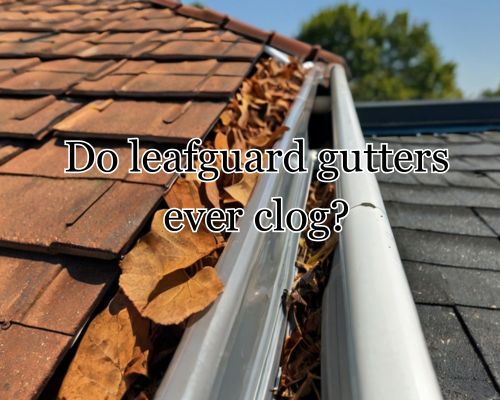
In this article, we’ll break down what LeafGuard gutters are, how they work, whether they truly offer a clog-free solution, and what West Palm Beach homeowners should consider before installation. Let’s get into the (clean) gutter truth.
What Are LeafGuard Gutters?
LeafGuard gutters, often referred to as gutter protection systems or gutter guards, are a patented one-piece design that integrates a curved hood to deflect leaves, twigs, and other debris while allowing water to flow through a seamless trough. Unlike traditional open gutters, LeafGuard systems aim to offer a maintenance-free solution by preventing clogs from forming in the first place.
Salient entities to note:
- LeafGuard® (a proprietary brand by Englert, Inc.)
- Seamless gutters
- Gutter protection systems
- Rainwater drainage systems
But do these claims hold water?
Do LeafGuard Gutters Ever Clog?
The Honest Answer: Rarely, But Not Never
While LeafGuard systems are engineered to be clog-resistant, no system can guarantee 100% immunity from blockage—especially over time and under extreme conditions. The design greatly reduces the chances of clogging compared to traditional gutters, but it doesn’t render your system infallible.
Here’s when clogging may occur:
- Heavy organic buildup: Even with a curved hood, fine debris like pollen, pine needles, or dust can accumulate over time.
- Improper installation: Systems not pitched correctly or attached poorly can cause backflow or pooling.
- Tropical storms: West Palm Beach is no stranger to hurricanes and heavy rainfall. During such events, large volumes of water mixed with wind-blown debris can overwhelm any gutter system.
- Animal nesting: Occasionally, birds or insects may try to nest near the hood of the gutter, leading to blockages at entry points.
In summary: clogging is possible, but extremely rare with proper installation and occasional inspection—especially in tropical environments like Palm Beach County. See gutter professional for more.
Benefits of LeafGuard Gutters in West Palm Beach
1. Reduced Maintenance
In a city surrounded by dense vegetation, from banyan trees to flowering shrubs, clogged gutters are a weekly threat. LeafGuard dramatically reduces the need for manual gutter cleaning, which is a huge plus for single-story and two-story homes across West Palm Beach neighborhoods like El Cid, Flamingo Park, and Southend.
2. Storm Protection
Heavy rain is a regular guest in South Florida. LeafGuard systems can handle up to 32 inches of rainfall per hour, far more than even the heaviest downpours recorded in the region. That’s critical for protecting fascia boards, soffits, and your home’s foundation from water damage.
3. Pest Deterrence
Standing water in clogged gutters can become a breeding ground for mosquitoes—a particular concern in humid regions like Palm Beach County. By keeping gutters clear, LeafGuard helps minimize pest infestations.
LSI Keywords and Semantic Phrases
To understand the topic deeper and rank better in search, we integrate Latent Semantic Indexing (LSI) keywords and topical clusters, such as:
- Seamless gutter systems
- Gutter clog prevention
- Florida rain gutter protection
- Gutter maintenance in tropical climates
- Rainwater drainage solutions
- Leaf-free gutter systems
- Best gutters for hurricane-prone areas
These phrases help Google—and your reader—connect the dots between the question (“Do LeafGuard gutters ever clog?”) and related themes in roof drainage, home improvement, and storm preparedness.
What Local Homeowners Are Saying
Homeowners in West Palm Beach who have installed LeafGuard systems often praise the reduced need for cleaning and the peace of mind during storm season.
“We had our LeafGuard system installed last summer. Even through Hurricane Idalia, our gutters stayed clear. We haven’t touched them since,” says Don M., a homeowner in Northwood Hills.
“It’s an investment, but when you factor in what you save on gutter cleaning services and potential roof repairs, it pays for itself,” shares Liza T. from SoSo (South of Southern).
Comparing Gutter Guard Systems in Florida
LeafGuard is not the only player in the game. Here’s how it stacks up against other systems commonly used in South Florida:
| Feature | LeafGuard | Mesh Guards | Foam Inserts | Standard Gutters |
|---|---|---|---|---|
| Clog Resistance | ★★★★★ | ★★★★☆ | ★★☆☆☆ | ★☆☆☆☆ |
| Durability | ★★★★★ | ★★★☆☆ | ★★☆☆☆ | ★★★☆☆ |
| Hurricane Resilience | ★★★★★ | ★★★★☆ | ★★☆☆☆ | ★★★☆☆ |
| Maintenance Required | ★☆☆☆☆ | ★★★☆☆ | ★★★★☆ | ★★★★★ |
As you can see, for tropical climates like West Palm Beach, LeafGuard offers the most long-term protection with minimal effort.
Costs and Installation in West Palm Beach
LeafGuard gutter systems are a premium product. The cost typically ranges from $20 to $35 per linear foot, depending on the size of your home and roofline complexity. For an average-sized home in West Palm Beach (around 2,000 sq ft), total installation costs could be between $2,000 and $5,000.
That may seem steep, but consider this:
- No more paying for biannual gutter cleaning (~$150–$300 per session).
- Lower risk of water damage-related repairs.
- Possible home insurance discounts for hurricane-resilient upgrades.
For best results, hire a licensed local gutter professional who understands Florida building codes and regional climate demands.
Final Verdict: Should You Get LeafGuard Gutters?
If you’re a homeowner in West Palm Beach, Florida, the answer is a resounding yes—if your goal is to minimize gutter-related headaches. While no system is 100% clog-proof, LeafGuard comes impressively close and is built to withstand Florida’s extreme weather conditions.
So, do LeafGuard gutters ever clog? Technically, they can—but it’s rare and usually preventable with proper installation and minor maintenance. In most cases, they outperform traditional gutters by a mile, especially in leafy, rain-heavy locales like Palm Beach County.
Local Resources & Next Steps
Want to get a quote or see systems in action? Check out these West Palm Beach gutter specialists:
- Gutter Professionals Inc. – West Palm Beach, FL
- Seamless Gutters by Eagle Roofing – Serving Palm Beach County
- StormGuard Gutters & Roofing – Local hurricane retrofit experts
📞 Pro tip: Ask about hurricane clips and fascia reinforcement when getting LeafGuard installed—it’s another layer of storm resilience!
Conclusion
LeafGuard gutters are a smart investment for West Palm Beach homeowners who want to protect their property, reduce maintenance, and sleep soundly when the summer storms roll in. While they’re not 100% immune to clogs, their performance, durability, and peace of mind make them a leading choice in gutter systems.
💬 Still wondering if they’re right for your home? Consult a local expert for an on-site evaluation and gutter health check. Your fascia (and your free weekends) will thank you.
…
- June 11, 2025
- By Rebecca Washington
- Uncategorized
Which Lasts Longer: Vinyl or Aluminum Gutters? A West Palm Beach Homeowner’s Guide
Which Lasts Longer: Vinyl or Aluminum Gutters? A West Palm Beach Homeowner’s Guide
Gutters are the unsung heroes of any home, silently guiding rainwater away from your roof, walls, and foundation. But in a place like West Palm Beach, Florida, where torrential downpours and blistering sun are part of the climate routine, choosing the right gutter material is more than just a matter of aesthetics—it’s about longevity, durability, and value.
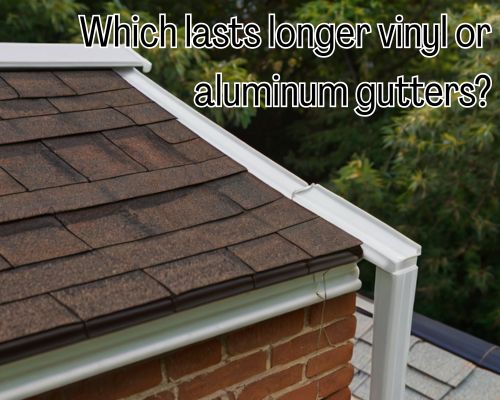
So, which lasts longer: vinyl or aluminum gutters? If you’re a homeowner in South Florida considering gutter replacement or installation, this guide will help you decide which material suits your needs, climate, and budget.
The Basics: What Are Vinyl and Aluminum Gutters?
Vinyl gutters are made from a type of plastic known as PVC (polyvinyl chloride). They are lightweight, relatively inexpensive, and easy to install—often as a DIY project.
Aluminum gutters, on the other hand, are crafted from lightweight metal and are among the most commonly installed gutter systems in the United States. They are favored for their balance between affordability, durability, and aesthetic versatility.
In West Palm Beach, where salty air, high humidity, and heavy rainstorms are environmental norms, how do these two materials hold up over time?
Durability in West Palm Beach’s Climate
🌀 Vinyl Gutters: The Sunshine State’s Nemesis
In theory, vinyl gutters should last between 10 and 20 years. However, that’s under moderate, less extreme weather conditions. In Palm Beach County, where the UV index can soar and summer thunderstorms are common, vinyl tends to warp, crack, or become brittle faster than expected.
Humidity, intense heat, and salt-laden breezes from the Atlantic can accelerate the breakdown of plastic-based materials. Vinyl gutters often become brittle and discolored, requiring frequent inspections and premature replacements.
👉 Estimated lifespan in West Palm Beach: 8–12 years, with maintenance
🔩 Aluminum Gutters: Built for the Tropics
Aluminum gutters are much better suited for the local climate. They resist rust, don’t crack under the pressure of UV rays, and hold their shape under extreme conditions. With the right installation and minimal upkeep, aluminum gutters can last between 20 and 30 years in West Palm Beach.
They also perform better in torrential downpours, common during Florida’s rainy season, especially when paired with seamless gutter systems that reduce leakage risks.
👉 Estimated lifespan in West Palm Beach: 20–30 years, potentially longer with protection (e.g., gutter guards)
Maintenance and Repairs: What’s Easier to Live With?
Vinyl gutters are easy to install, which makes minor repairs less labor-intensive. However, this also means they can easily detach or sag under pressure from heavy rainfall or clogged debris—especially without professional installation.
Aluminum gutters, though slightly more difficult to install due to their metal structure, tend to require less maintenance. They’re more resistant to sagging and are usually installed with hidden hangers that hold them more securely to your fascia board.
Local Insight
In West Palm Beach, many homeowners opt for aluminum seamless gutters because they reduce the chance of leakage at joints, which is a common problem in older vinyl gutter systems. Local gutter installation companies like Seamless Gutters of South Florida or Palm Beach Gutter Experts report significantly fewer repair calls from aluminum-based systems.
Cost Considerations: Upfront vs. Long-Term
Vinyl gutters are undeniably cheaper. For a standard single-story home, you might pay $3 to $5 per linear foot installed. That makes them appealing to budget-conscious homeowners doing DIY installs.
Aluminum gutters, however, cost around $6 to $12 per linear foot, depending on whether you opt for sectional or seamless systems, and whether protective coatings like baked enamel are added.
But here’s the catch: when you factor in lifespan, maintenance, and climate resilience, aluminum often becomes the more cost-effective option for homeowners in West Palm Beach. See gutter professionals for more.
Aesthetic Flexibility and Curb Appeal
While vinyl gutters come in a limited color palette and can’t be painted, aluminum gutters offer significantly more customization. In coastal Florida neighborhoods like Flamingo Park or El Cid, homeowners often choose baked enamel aluminum gutters to match their Mediterranean Revival or Art Deco home styles.
Plus, aluminum holds paint well, allowing future color changes as you update your home’s exterior.
Sustainability and Environmental Impact
Environmentally conscious homeowners should know: aluminum is recyclable. Many gutter installation companies in the West Palm Beach area offer eco-friendly removal and recycling of old aluminum systems.
Conversely, vinyl is less sustainable, and its degradation can release harmful chemicals over time, especially under high heat—a recurring condition in South Florida.
Local Expert Advice: What Do Contractors Say?
We spoke with local roofing and gutter contractor Sergio Martinez of Palm Coast Exteriors, who shared this insight:
“In West Palm Beach, we install aluminum gutters 4 to 1 over vinyl. The sun just eats vinyl alive out here. Aluminum costs more upfront, but it holds up better to our weather and saves homeowners on repairs down the road.”
Additionally, homeowners associations (HOAs) in communities like Ibis, Breakers West, or The Acreage often require metal-based gutter systems to preserve neighborhood aesthetic standards and minimize maintenance issues.
Final Verdict: Which Lasts Longer in West Palm Beach?
| Feature | Vinyl Gutters | Aluminum Gutters |
|---|---|---|
| Estimated Lifespan | 8–12 years | 20–30 years |
| Climate Resistance | Low | High |
| Maintenance Frequency | High | Low |
| Customization Options | Limited | Wide range |
| Cost Efficiency (Long Term) | Lower | Higher |
| Environmental Impact | Less eco-friendly | Recyclable |
Conclusion: In West Palm Beach, Florida, aluminum gutters are the clear winner in terms of durability, cost-efficiency, and performance. While vinyl gutters might be tempting for their lower price and ease of installation, they simply don’t hold up well against Florida’s sun-soaked, storm-heavy conditions.
Pro Tip: Schedule Annual Gutter Inspections
Regardless of which material you choose, regular inspections—especially after hurricane season—can extend the life of your gutter system. Consider scheduling a gutter cleaning and inspection every fall, especially in coastal cities like West Palm Beach where debris from palm trees, sea salt, and tropical storms can clog systems quickly.
Ready to Upgrade Your Gutters?
If you’re still wondering “which lasts longer: vinyl or aluminum gutters,” and you live in the West Palm Beach area, the answer is pretty clear: go with aluminum. Local gutter professionals offer free consultations and can help you choose the best gutter profile, color, and accessories (like gutter guards) to keep your home protected year-round.
👉 Contact local gutter pros in West Palm Beach to get a personalized quote that suits your home’s design and weather exposure.
…
- June 9, 2025
- By Rebecca Washington
- Uncategorized
How Do You Fix Gutter Gaps? A Homeowner’s Guide for Melbourne, Australia
How Do You Fix Gutter Gaps? A Homeowner’s Guide for Melbourne, Australia
Gutters are often the unsung heroes of our homes—silently diverting rainwater, protecting foundations, and shielding roofs and walls from costly water damage. But when gaps form in your guttering system, especially in the unpredictable climate of Melbourne, Australia, problems can escalate quickly. From water leaks to structural damage, neglected gutter gaps can lead to expensive repairs if not addressed early.
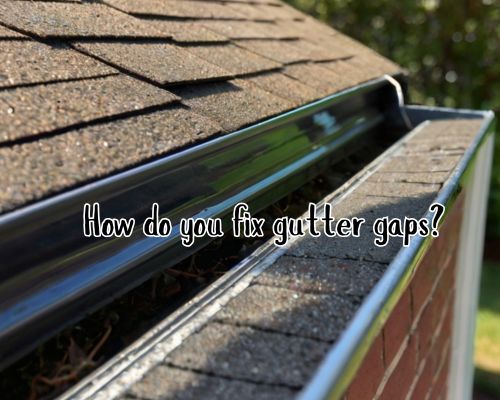
So, how do you fix gutter gaps effectively and permanently? With Gutter Cleaning Melbourne, we will walk you through the causes, tools, solutions, and when to call in a local roofing expert or licensed roof plumber.
Why Do Gutter Gaps Happen?
Before jumping into how to fix gutter gaps, it’s important to understand why they occur. The most common causes include:
- Expansion and contraction due to Melbourne’s fluctuating temperatures.
- Poor installation or sagging brackets over time.
- Blocked gutters that increase weight and cause joints to separate.
- Loose fascia boards, often due to timber rot.
- Corrosion or rust, especially in older metal guttering systems.
- Aging sealant that has deteriorated at the joints or corners.
Gutter gaps usually appear at the seams or joints, where sections of the guttering system connect. Left unchecked, water can leak through these gaps, damaging your home’s exterior walls, eroding landscaping, and even seeping into the foundation.
Tools and Materials Needed for Gutter Gap Repair
If you’re handy and the gaps are minor, fixing them yourself is feasible. Here’s a basic list of materials:
- Ladder (with stabilisers for safety)
- Gutter sealant (silicone or polyurethane-based)
- Gutter screws or pop rivets
- Gutter brackets or hangers
- Flashing tape or rubber gasket
- Wire brush and rag
- Silicone gun
- Tin snips (for metal gutters)
Remember, safety first. Melbourne homeowners should avoid climbing roofs during wet or windy conditions, especially in the winter months when rainfall peaks.
Step-by-Step: How Do You Fix Gutter Gaps?
1. Inspect the Gutter System
Start with a thorough inspection. Look at:
- Joints and seams for visible gaps
- Rust or corrosion spots
- Brackets pulling away from the fascia
- Clogged downpipes or overflowing water marks
Also check for signs of roof edge deterioration or fascia board rot, which are common in older Melbourne homes built before 1990.
2. Clean the Gutter Thoroughly
Use a hose or scoop to clear out debris—leaves, twigs, even bird nests. This ensures proper adhesion for sealants and reduces weight stress on the system.
Pro tip: Install gutter guards afterward to prevent future blockages, especially in leafy suburbs like Toorak, Camberwell, or Eltham.
3. Reseal Joints and Corners
Apply a high-quality gutter sealant to all leaking seams. Remove the old, crumbling sealant with a wire brush, then:
- Dry the area with a cloth
- Apply new sealant in a continuous bead
- Smooth with a putty knife
- Allow it to cure per manufacturer instructions
For PVC or uPVC gutter systems, use a compatible plastic-specific sealant.
4. Tighten or Replace Fasteners
Gutter sections may have shifted due to rusted or loose screws. Replace missing or rusted fasteners and add new brackets if sagging occurs. In coastal Melbourne suburbs like Brighton or Sandringham, use galvanised or stainless-steel screws to resist salt-air corrosion.
5. Add Gutter Joiners or Flashing Tape
If the gaps are too wide for sealant alone, use gutter joiners or flashing tape. These are especially effective for:
- Box gutter systems common in inner-city homes
- Half-round or quad gutters in modern renovations
Ensure the joiners are properly sized for your gutter profile (e.g., 115mm or 150mm).
When to Call a Professional Roof Plumber
While some DIY solutions work, certain situations require professional intervention. Consider calling a certified Melbourne roof plumber if:
- Gaps keep reappearing after multiple fixes
- The fascia board or soffit is water-damaged
- Gutter slopes are incorrect (water pooling)
- You have a multi-storey property or steep pitch roof
Licensed plumbers in Victoria are trained to handle complex drainage issues and comply with Australian Standards (AS/NZS 3500). A roof plumbing service might suggest a partial or full gutter replacement, especially for aging systems over 20 years old. For professional needs, go to Gutter Cleaning Melbourne.
Prevention Tips for Melbourne Homes
The best way to avoid fixing gutter gaps every few months is to be proactive:
- Schedule gutter cleaning twice a year: Once in late autumn (after leaf fall) and again in early spring.
- Install leaf guards: Especially useful in treed suburbs like Kew, Montmorency, or Belgrave.
- Inspect after major storms: Melbourne’s flash floods and windstorms can shift gutters unexpectedly.
- Choose durable materials: Colorbond or zincalume gutters offer longevity and are better suited to Melbourne’s climate.
- Ensure proper gutter slope: The standard fall should be 1:500 to ensure water flows toward the downpipe.
Gutter Maintenance Cost in Melbourne
Wondering how much gutter repairs might set you back? Here’s a ballpark:
- Minor gap repair (DIY materials): $50–$120
- Professional resealing and alignment: $150–$300
- Partial replacement of gutter segments: $300–$700
- Full gutter replacement (typical 3-bedroom home): $1,500–$3,000
Prices vary depending on property access, roof height, and materials. Be sure to get multiple quotes from local Melbourne-based roofing contractors or check platforms like hipages or ServiceSeeking for verified tradespeople.
Final Thoughts: Fix Today, Save Tomorrow
So, how do you fix gutter gaps? In summary: inspect, clean, seal, and reinforce. With Melbourne’s unique blend of wet winters, leafy suburbs, and architectural variety—from Victorian cottages to modern townhouses—maintaining your gutter system is crucial.
Don’t wait until water is trickling down your walls or flooding your garden beds. Whether you’re in Carlton, Essendon, or St Kilda, timely gutter maintenance protects both your home and your wallet.
If in doubt, consult a local expert. A simple seal today could save thousands tomorrow.
…
- June 9, 2025
- By Rebecca Washington
- Uncategorized
What Is the Best Stuff to Fix Leaky Gutters? A Melbourne Homeowner’s Guide
What Is the Best Stuff to Fix Leaky Gutters? A Melbourne Homeowner’s Guide
Leaky gutters might seem like a minor inconvenience, but in Melbourne’s ever-changing climate—from torrential downpours in the Dandenong Ranges to the salty sea breeze of Port Phillip Bay—they can quickly become a serious home maintenance issue. Left unchecked, dripping gutters can lead to damaged fascia boards, foundation erosion, and even internal mould problems.
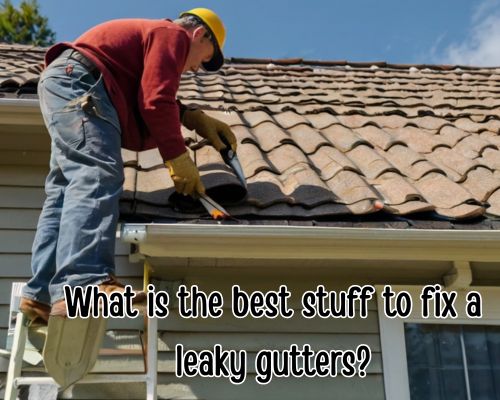
So, what is the best stuff to fix a leaky gutter? The answer isn’t one-size-fits-all. In this comprehensive guide, we explore the top gutter repair products and techniques best suited for Melbourne homes—considering local conditions, building materials, and common failure points.
Understanding Why Gutters Leak in Melbourne
Before we can fix a leak, it’s crucial to understand why it started. Melbourne’s weather swings—from 40°C summer days to hailstorms in winter—place unique stress on gutter systems. Add in leaf litter from native eucalyptus trees, and you’ve got the perfect recipe for wear and tear.
Here are the most common causes of leaky gutters in Melbourne suburbs like Fitzroy, Frankston, or Ferntree Gully:
- Rust and corrosion (especially in older steel systems)
- Cracked seals or joints
- Blockages leading to overflow
- Sagging or misaligned gutters
- Damaged or deteriorated guttering material
Identifying the root cause ensures you’re not just applying a temporary fix, but a long-term solution. You may also see gutter services for your needs.
The Best Materials and Products to Fix Leaky Gutters
Let’s break down the top solutions—ranging from DIY patch jobs to professional-grade repairs.
1. Silicone-Based Gutter Sealant
✅ Best for: Small cracks, minor leaks around joints or seams
📍 Melbourne relevance: Sealants with UV and water resistance are critical for local weather shifts
High-quality silicone-based sealants are a homeowner’s first line of defense. In suburbs like Brighton or St Kilda where homes are exposed to coastal conditions, look for products labeled “marine-grade” or “UV stabilised.” Popular Australian brands like Selleys Storm Sealant and Parfix Roof & Gutter Sealant are readily available at Bunnings.
🔧 Tip: Clean and dry the area thoroughly. Apply sealant in dry weather, ideally between 18–25°C.
2. Bitumen-Based Gutter Repair Tape
✅ Best for: Emergency fixes, patching small holes or cracks
📍 Use case in Melbourne: Great for fast repairs during rainy months like June or July
Waterproof repair tape is an underrated hero. It adheres even to damp surfaces, making it perfect for Melbourne’s unpredictable showers. Products like Flashband or 3M Aluminium Bitumen Tape work well on both metal and plastic gutters.
🎯 Pro insight: While convenient, this should be seen as a temporary fix until a more permanent repair is done.
3. Aluminium or Metal Patches
✅ Best for: Holes or rust damage in steel gutters
📍 Relevance: Many Melbourne homes (particularly in older areas like Carlton or Brunswick) have galvanized steel gutters prone to rust
For metal gutters, an aluminium patch with waterproof epoxy adhesive provides a durable fix. This method is often used by licensed roofing contractors around Melbourne and can last for several years with proper sealing.
4. Gutter Replacement Sections
✅ Best for: Severely damaged or rusted-out sections
📍 Melbourne context: Widespread in renovations around inner suburbs like Richmond, where period homes require bespoke restoration
Sometimes, repair isn’t the answer—replacement is. Modern Colorbond® guttering, popular throughout Victoria, offers colour-matching to existing roofs and superior corrosion resistance.
🛠️ Local tip: Always use a licensed plumber or roof plumber in Victoria. According to the Victorian Building Authority (VBA), gutter replacement falls under regulated work.
5. Waterproofing Membranes
✅ Best for: Internal box gutters and roof valleys
📍 Seen in: Melbourne CBD, Southbank apartments, and heritage townhouses with concealed gutter systems
These thick rubber or polyurethane coatings create a flexible, watertight layer. They’re ideal for flat-roof drainage areas that overflow during heavy rain.
Gutter Maintenance: Prevention Beats the Patch
Repair is only half the battle. Regular gutter maintenance can prevent 90% of leaks. Here’s what professionals across Melbourne recommend:
- Install Gutter Guards: Especially important in leafy suburbs like Doncaster or Eltham. Mesh guards prevent leaf build-up and nesting.
- Biannual Cleaning: Schedule in autumn and spring. Consider local services like “Gutter-Vac Melbourne East” or “Gutter Knight Victoria.”
- Check Downpipes: Blocked or undersized downpipes are common culprits for overflow.
- Roof Inspections: Look for sagging or ponding near valleys.
Hiring a Professional vs DIY
DIY is viable for small leaks, but for persistent problems, hiring a professional (see gutter services) is wise. In Melbourne, roofing and gutter repairs require licensing due to safety and compliance regulations.
Use services listed on ServiceSeeking or HiPages, and always verify credentials via the Victorian Building Authority. Look for tradespeople with insurance and experience in Melbourne’s unique housing stock—Victorian terraces, Edwardian homes, and modern developments all pose different challenges.
Cost of Gutter Repairs in Melbourne
Here’s a breakdown of typical repair costs in Melbourne (2025 estimates):
| Service | Cost Range (AUD) |
|---|---|
| Silicone sealing | $100–$250 |
| Patch repairs | $150–$350 |
| Sectional replacement | $300–$800 |
| Full gutter replacement | $1,000–$2,500 |
| Gutter guard installation | $500–$1,500 |
Prices vary based on home height, gutter type (Colorbond, PVC, zincalume), and access.
Eco-Friendly Gutter Repair Options
Melbourne is a green-conscious city. Sustainable products like recycled aluminium patches, eco-safe sealants, and rainwater harvesting systems (like those seen in homes across Northcote or Preston) are increasingly popular.
Also, opting for recyclable Colorbond® steel for gutter replacements aligns with Victoria’s 2030 sustainability goals.
Final Thoughts: What’s Truly the Best Stuff?
So, what is the best stuff to fix leaky gutters in Melbourne? It depends on the problem—but here’s a quick cheat sheet:
- Hairline cracks or seam leaks: Silicone-based gutter sealant
- Small holes or temporary repairs: Bitumen repair tape
- Rust spots on metal gutters: Aluminium patch with epoxy
- Long-term durability: Colorbond replacement sections
- Box gutters or internal gutters: Waterproofing membranes
For long-term results, always combine the right repair method with regular inspections and gutter cleaning.
Need Gutter Repairs in Melbourne?
Whether you’re in Glen Waverley, Essendon, or Mornington Peninsula, local trades are ready to help. Search Google for “licensed gutter repair Melbourne” or get instant quotes from reputable platforms like Airtasker, Oneflare, or Hipages.
And remember—fixing a leaky gutter now saves thousands in water damage later.
💧 Don’t wait for a downpour—seal the leak today.
…
Categories
About Us

A company environment is a set of factors, such as modern technologies and funds, that have…
Let’s Talk

Harold A. Wiggins
Address:
Lagrange, GA 30240
Phone:
706-883-0040
Email:
talk@killarney-innovation.com
Must Read
Recent Posts
- Innovative Motorcycle Shipping Options for Extreme Sports Riders
- Energy Healing and Reiki Explained: How Gentle Energy Work Restores Balance and Calm
- How Custom Built-Ins Transform Homes and Businesses in Dallas, TX
- Beyond Dinner and Drinks: How Playfulness Strengthens London Love
- Dana Point Mover Your Trusted Partner for a Seamless Move
- Can Mold Inspections Los Angeles Improve Indoor Air Quality?
- London’s Cosiest Cafes: Fueling Intimate Connections on Your Next Date
- Why Do So Many Patients Seek a Psychiatrist in New York for Specialized Care?
- Essential Guide to Plumbing Needs in Lompico, Santa Cruz
- Authentic Confidence – The Magnet for Meaningful London Relationships
- Beyond the Tube: Turning a Central Line Spark into a Lasting London Relationship
- Interstate Movers You Can Trust for a Smooth and Stress-Free Move
- The London Blueprint: Why Slow Dating is the Foundation for Lasting Relationships


